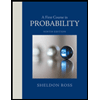
A First Course in Probability (10th Edition)
10th Edition
ISBN: 9780134753119
Author: Sheldon Ross
Publisher: PEARSON
expand_more
expand_more
format_list_bulleted
Concept explainers
Question

Transcribed Image Text:2. If X is a normal random variable with mean u 3 and variance o2 16, find P{X< 11},
P{X>-1 }
Expert Solution
This question has been solved!
Explore an expertly crafted, step-by-step solution for a thorough understanding of key concepts.
This is a popular solution
Trending nowThis is a popular solution!
Step by stepSolved in 3 steps

Knowledge Booster
Learn more about
Need a deep-dive on the concept behind this application? Look no further. Learn more about this topic, probability and related others by exploring similar questions and additional content below.Similar questions
- You have been asked to determine if two different production processes have different mean numbers of units produced per hour. Process 1 has a mean defined as µ₁ and process 2 has a mean defined as µ2. The null and alternative hypotheses are Ho: μ₁ −μ₂ ≤0 and H₁ : µ₁ −µ₂ > 0. The process variances are unknown but assumed to be equal. Using random samples of 36 observations from process 1 and 49 observations from process 2, the sample means are 60 and 50 for populations 1 and 2 respectively. Complete parts a through d below. Click the icon to view a table of critical values for the Student's t-distribution. a. Can you reject the null hypothesis, using a probability of Type I error α = 0.05, if the sample standard deviation from process 1 is 28 and from process 2 is 23? (Round to three decimal places as needed.) The test statistic is t =arrow_forward(e) Show that the sample mean of a simple random sample (drawn without replacement from a normal population) is dis- tributed normally with mean u and variance -² (1--=-1). n where N and n are population and sample sizes respectively. 4 In the 1 1 TIarrow_forwardImagine a family member looks over your shoulder as you look at the variance equation Σki=1(xi − μ)2P(X = xi) and asks why the P(X = xi) term is there. What would you say?arrow_forward
- Suppose X1,..., Xn is a random sample from an exponential distribution with mean e. If X = 17.9 with n = 50, find (a) a one-sided 95% confidence interval for 0, and (b) a two-sided 95% confidence interval for 0.arrow_forwardSuppose that X₁,..., Xn are i.i.d. from a normal population with mean μ and variance o². Calculate the expected value and the variance of the sample mean X and find the distribution of √n(X − µ).arrow_forwardIf X is a negative binomial rv, then Y= r+Xis the total number of trials necessary to obtainr S’s. Obtain the mgf of Y and then its mean valueand variance. Are the mean and variance intuitively consistent with the expressions for E(X)and V(X)? Explainarrow_forward
- Compute the standard score (Z-score) for x, when x = 21, the mean of the distribution = 27, and the variance (S2) = 9. Z = %3D O 2 -2 .67 -.67arrow_forwardA random sample of n = 19 winter days in Denver gave a sample mean pollution index x1 = 43. Previous studies show that o1 = 10. For Englewood (a suburb of Denver), a random sample of n2 = 18 winter days gave a sample mean pollution index of x2 = 34. Previous studies show that o2 = 13. Assume the pollution index is normally distributed in both Englewood and Denver. Do these data indicate that the mean population pollution index of Englewood is different (either way) from that of Denver in the winter? Use a 1% level of significance. (a) What is the level of significance? State the null and alternate hypotheses. O Ho: H1 H2 O Ho: H1 = l2; H1: H1 < µ2 (b) What sampling distribution will you use? What assumptions are you making? O The standard normal. We assume that both population distributions are approximately normal with unknown standard deviations. O The Student's t. We assume that both population distributions are approximately normal with unknown standard deviations. O The Student's…arrow_forward
arrow_back_ios
arrow_forward_ios
Recommended textbooks for you
 A First Course in Probability (10th Edition)ProbabilityISBN:9780134753119Author:Sheldon RossPublisher:PEARSON
A First Course in Probability (10th Edition)ProbabilityISBN:9780134753119Author:Sheldon RossPublisher:PEARSON

A First Course in Probability (10th Edition)
Probability
ISBN:9780134753119
Author:Sheldon Ross
Publisher:PEARSON
